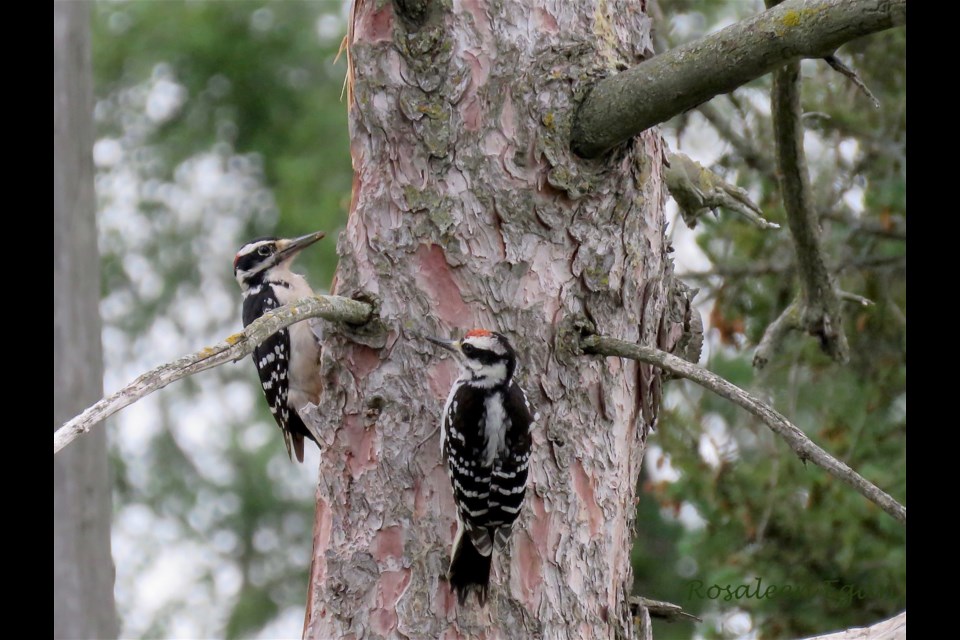I’ve had some fun recently watching a male hairy woodpecker feed a male fledgling on the standing remains of a tree that lost its top in a spring wind.
Both the male and the female hairy woodpecker feed offspring from their yearly brood. There can be three to seven eggs in a clutch and 28 to 30 days are spent as a nestling. Adults regurgitate and insert food in the mouths of the very young. Food is transferred from adult to older offspring through open beaks with heads at an angle. Birdsoftheworld.org says, “After fledging, young may be associated with a specific parent and are seen with parents for several weeks, often coming to feeders.” What I have been witnessing seems to be a case in point.
The site goes on to say the young often remain on same trunk or branch for hours and “within a few days, fledgling will increasingly explore its perch trunk or limb, occasionally ingesting discovered prey, but remains very much dependent on adults for most food.” It’s neat to read these things that confirm my observations of these two on the nearby tree.
Hairy woodpeckers feed on sap of damaged trees, some berries, seeds and nuts. Its primary food though is insects, including larvae of wood-boring beetles, ants, caterpillars and other such goodies.
Not only does “my” adult hairy woodpecker seem to find bugs in the dead tree; it roots through the sunflower seeds in my feeders scattering seeds everywhere thus feeding the neighbourhood.
That neighbourhood include starlings, grackles, doves, pigeons, squirrels, chipmunks and even the occasional rabbit. All these congregate at the bottom of the feeder as the hairy woodpecker empties it to find the “just right” seed. The bottom feeders, so to speak, are not so choosy. This animal interplay seems a good lesson in co-operative living.
Allaboutbirds.org talks about hairy woodpeckers appearing in great numbers to eat bark beetle larvae as they infest thousands of live trees. It goes on to say, “A similar pattern happens in forests that have recently burned: wood-boring beetles become very numerous. Hairy and other woodpecker species can become very common in these areas and achieve high nesting success. Hairy woodpeckers have helped control pest outbreaks such as codling moths in orchards.”
The last sentence gave me pause and I wondered if they also eat gypsy moth caterpillars that are currently invading this area. I did a quick internet search and found a page on gypsy moths on massaudubon.org: Some native birds, such as cuckoos, downy woodpeckers, grey catbirds, and common grackles, will eat gypsy moth caterpillars but, unfortunately, not in large enough quantities to have an effect during an outbreak.” As a side-note, I’ll add the website mentions some actual benefits of these invasive moths.
It is curious that downy woodpeckers are mentioned. Despite the difference in taste for caterpillars, they are “mini-me” look-alikes of hairy woodpeckers. The colourations are similar but they are smaller from tip to tail and have a much shorter beak. It’s not really unusual to have both hairy and downy woodpeckers in the same area. Downy woodpeckers, nevertheless, are more likely to be seen in suburbs and small parks. Hairy woodpeckers prefer areas that are heavily forested with large trees. It seems their size matches their habitat.
I am fortunate to have both species in this neighbourhood. I am also fortunate to see another generation, of yet another species, move on in the world.
I share experiences of bird visitors to this property with readers every couple of weeks. Until next time, keep your eye to the sky, and look for birds that may come by.
Rosaleen Egan is a freelance journalist, a storyteller and a playwright. She blogs on her website, rosiewrites.com.
